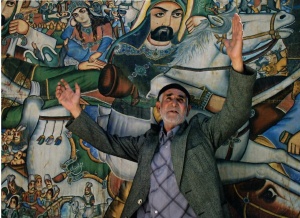Ebrahim dehdashti: Difference between revisions
No edit summary |
No edit summary |
||
| (2 intermediate revisions by 2 users not shown) | |||
| Line 33: | Line 33: | ||
*Ardalan, hamidreza (2008). Picture-storyteller masters of iran, the Iranian academy of the art, 2008, volume 10. ISBN: 978-964-2986-439(vol.10). 978-964-2986-002(set). | *Ardalan, hamidreza (2008). Picture-storyteller masters of iran, the Iranian academy of the art, 2008, volume 10. ISBN: 978-964-2986-439(vol.10). 978-964-2986-002(set). | ||
[[Category: Performing Art]] | [[Category: Performing Art]] | ||
[[Category: Ritual Dramatic Art]] | [[Category: Ritual Dramatic Art]] | ||
[[Category:Artists]] | |||
[[Category:Contemporary Artists]] | |||
[[Category:Art]] | |||
[[fa:ابراهیم ده دشتی]] | |||
Latest revision as of 11:12, 27 November 2022
Ebrahim Dehdashti (born in 1938) is an Iranian Pardekhan who began Pardekhani at the age of fifteen. Morshed Ebrahim follows a ritual way in curtain-storytelling. In this method the expression of the text is the pivot of the changes of situation, movements and indications. Control over the Pardekhani manners lead his performance to become almost as a ceremony.
Ebrahim dehdashti | |
|---|---|
 | |
| Born | 1938 Bam-Kerman |
| Nationality | Iranian |
| Known for | Pardekhani |
| Patron(s) | Darvish Namak Bami |
Performance MethodEdit
In Ebrahim Dehdashti's performance, before the proceeding to sections and parts of the performance, he takes the audience to a brief summary of the events of Karbala related stories so that with this general look they can relate to the portraits of the curtain. What is meant by brief generalities is the connecting of things and matters throughout history and even before and after that. The parts are transformed into movement, expression and thought and so are no more counted as being parts. So in the general atmosphere of ceremony at times the singer, narrator and audience come to witness a part of the whole. In the general atmosphere of ceremony attention to the parts is never intended. Only when the Pardekhan has for any reason no skill or knowledge, the audience shows their protest in the simplest way by getting up and leaving the performance and therefore damaging the gathering.
Reciting MethodEdit
Corresponding to the performance of the movements, postures, spoken prose and sung poetry, Morshed Ebrahim Dehdashti uses set patterns in voice tone, melody and intervals. The lyrical and rhythm tendencies of some of the melodies show his influence from the music of Shiraz and its lyrical songs.
NarrationEdit
Morshed Dehdashti narrates the story of Darvish Kaboli. Darvish Kaboli hears the voice of children of Imam Hussain's family in the desert of Karbala crying for thirst. Darvish goes to the Euphrates and fills his Kashkul with water and goes to Imam Hussain to present it to him. Imam Hussain does not accept his gift and asked the Darvish to leave Najaf to save his own life while telling the news of his and his followers' martyrdom to Imam Ali his father whose grave is there. The good and faithful Darvish does not accept the suggestion of the Imam because he wants to join the battlefield. After this, he is martyred having killed dozens of the enemy.
SourceEdit
- Ardalan, hamidreza (2008). Picture-storyteller masters of iran, the Iranian academy of the art, 2008, volume 10. ISBN: 978-964-2986-439(vol.10). 978-964-2986-002(set).